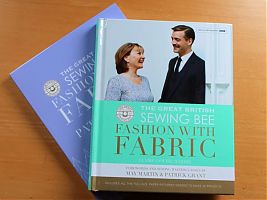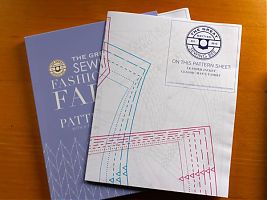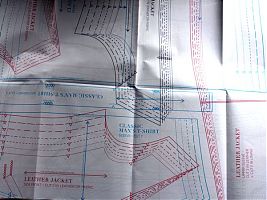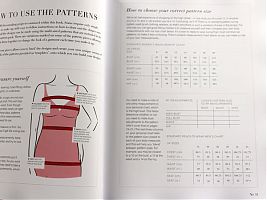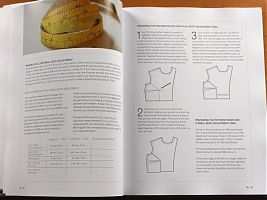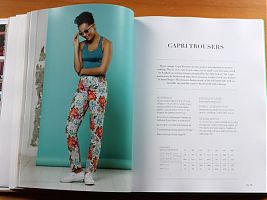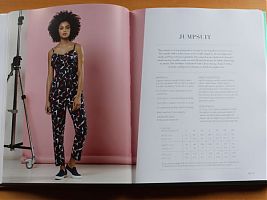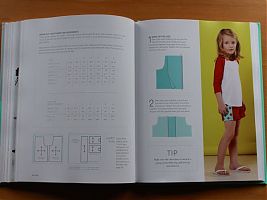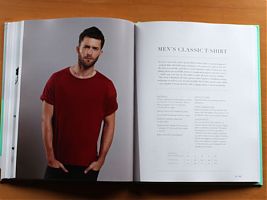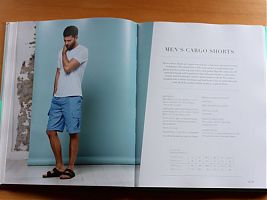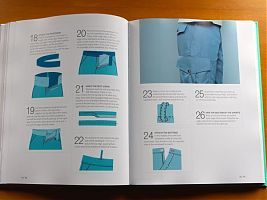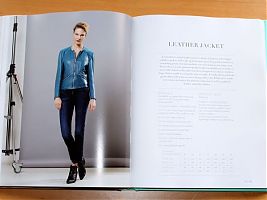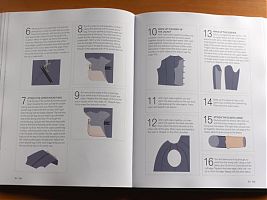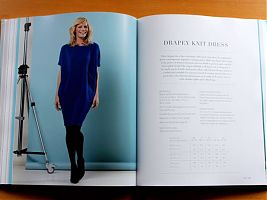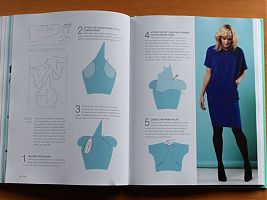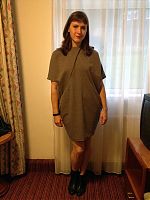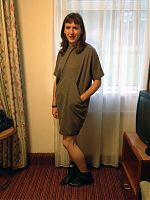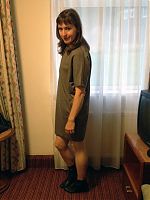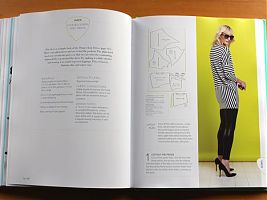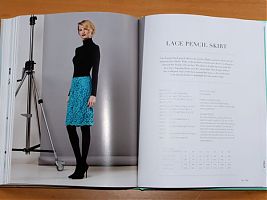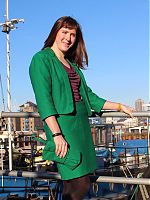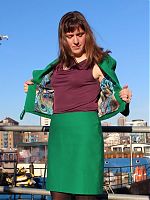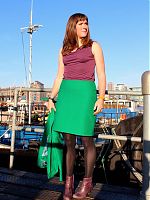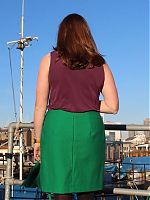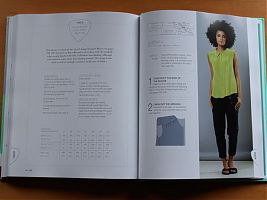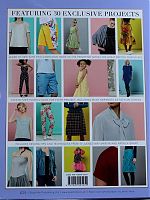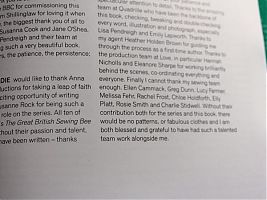This is not an unbiased review – if you recall, I worked behind the scenes on the production of the third series of The Great British Sewing Bee tv show, then again on the Children in Need specials (which were actually recorded after the main series, despite airing first), and right after that was done, I started work on the book which accompanies the series, The Great British Sewing Bee: Fashion with Fabric, under the amazing, dedicated, and super talented Claire-Louise Hardie (aka “the thriftystitcher”).
But even though I spent several months as part of the sewing team who developed, adapted, sewed, illustrated, and assisted with the patterns in this book, I have zero financial stake in the sales of this book – I’ve already been paid for my work, regardless if there are zero sales or several million. So this review is unbiased in that regard anyway.
But really, I mostly want to show you all what’s in this book, because a) myself and the team worked really freaking hard to deliver a book chock full of quality patterns, and b) because it really is the perfect book that intermediate/advanced sewists have been craving for a long, long, time. Don’t get me wrong – there are some easy, beginner styles in here, too, but there are loads of projects that are more advanced and have really interesting shapes and design lines.
It should really say something that I spent months of my life sewing up these patterns (both the ones you see as samples in the book, but many, many test versions you don’t see) and I still want to make a ton more. Seriously.
But let’s start with the patterns, shall we?
It’s a great sign that the pattern sheet stack is nearly as thick as the book itself, and each sheet is labelled on the upper right corner so you can see which patterns are printed on that sheet as you flip through the stack. The patterns need to be traced (here’s how I trace a pattern, btw), but they’re colour coded and really nicely spaced out – waaaaaay easier on the eyes than Burda’s pattern sheets, for example, and the sheets themselves are printed on hefty paper, a bit like the old KwikSew patterns. And the sheets aren’t freaking enormous like Vogue’s ones that cover my entire lounge!
Here’s the size chart, which ranges from size 8 (B32.5/W25.5/H36in) to 20 (B45.5/W38.5/H49.5in). Since there are also kids and mens patterns, too, there are (obviously!) different size charts for them. But there are also a few garments in the book which you draft from your own measurements, so if you’re outside the size range you can still make a few things (like Lorna’s curtain skirt from episode three!).
There’s the obligitary section at the start of any sewing book explaining about the supplies you need, how to trace a pattern, sew hand stitches, etc. To be honest, I always just skip past these since I know what I’m doing. But there’s also a section on common fit alterations like an FBA or trouser fitting alterations, too.
But onto the patterns themselves! I haven’t highlighted every single one, but rather pulled out my favourites (or ones where I’ve sewn the sample you see in the book!). For each pattern, you also get a “hack” variation which re-uses the same basic pattern pieces but in a new way to get a totally different look. IMHO, Claire-Louise did a great job in putting new twists on these patterns and showing how you can really make them your own.
In the Cottons section, you get a pattern for capri trousers, which you may recognise from the first episode!
Now, I’ve never been particularly on Team Jumpsuit, but I really like this jumpsuit pattern, and it totally grew on me throughout the book development progress – so much so that I’m planning on making this myself! If you’re not on Team Jumpsuit yet either, then you may be interested in the “hacks” for this pattern, which allow you to make a frilled camisole top or casual trousers instead.
Here you can see the adorable girls board shorts (which I made!), which combine jersey and quilting cottons in a really nice and easy-to-wear way. There are also patterns included for the longer, boy’s boxer-style shorts and the elephant ballerina costume, both of which featured in episode two.
And for the men in your life, you get patterns for a classic men’s teeshirt and cargo shorts, in addition to drafting instructions for a kilt, too. I’m proud to say that I sewed the samples for the teeshirt and the cargo shorts sewn in the book, and they’re both really modern styled – exactly the sort of fit your man would expect.
The Leather jacket is probably the most advanced pattern in the book, but my god is it ever lovely! There are full instructions for working with leather, sewing that zippered, welt pocket, and the pattern includes separately-drafted pieces for the facing and lining, too. The “hack” for this is a tweed and faux-leather version that is really very stylish, too.
In fact, having recently tried on my muslin for the Burda Jan 15 jacket yet again and found it’s still not fitting right in the shoulders, my next move is going to be to frankenpattern the Burda style lines onto this leather jacket pattern, as I know this fits me well from trying on the early samples!
And now we come to my absolute favourite pattern in this book, possibly favourite from the entire last year – the Drapey Dress. In my opinion, this pattern alone is worth the purchase price of the book. When we were developing this pattern, each and every one of us on the sewing team tried it on, and everyone looked great in it – seriously!
It’s an avant-garde shape, with a wide fit through the bust and shoulders, narrowing to a slimmer fit through the hips, but the length and diagonal lines make it really slimming indeed, and the side profile is really minimal, too. It also has pockets! Pockets! You can make it with long or short sleeves, so it works for most seasons, and it slips over the head, so there’s no fastenings to sew, either. It’s also easy to sew on a regular sewing machine (no overlocker needed!), and when I’ve sewn these, I’ve constructed the entire front on my sewing machine even though I own an overlocker. Best of all is how I feel when I wear it – super chic!
If you’re still skeptical and wondering how it looks on a non-model, well, here I am wearing the first ever drapey dress sample, early in the pattern development procress in a hotel room in Bolton last summer…
I’ve sewn 6(?) of these already and I still want to sew another for myself! That’s how great this dress is.
There’s also a stripey “hack” of this (which I also sewed), which adds on longer sleeves, changes the orientation of the stripes, and shortens the hem…
One of the more straightforward patterns is the lined, Lace pencil skirt, which can also be “hacked” to be a short, A-line tweed skirt. When I say straightforward, I mean in terms of design – lace requires careful planning and cutting, but there’s a really versatile pattern hiding in there, too.
It’s a really great, basic skirt that has NO darts in the front, two darts in back, an invisible zip in the CB, and nice shaping. And you’ve actually already seen me wearing it, when I made it to match my green jacket but couldn’t tell you where it was from!!
And finally, there’s a chiffon pussybow blouse pattern, but I actually like its sleeveless, collared, “hack” version even better.
If you pick this up in a book store you’d see a lot of patterns shown on on the back cover, but this isn’t even all of them!
My only slight disappointment with this entire book is that there aren’t any technical drawings of the designs, just photos. I think as a sewist, tech drawings are something I really like to have, and I’m honestly not sure why they weren’t included. It takes a little bit of extra time to look at the model photos, pattern piece fabric layouts, and kind of draw a picture in your mind, but I find it easier to remember a style’s details in drawing form.
But really, that’s my only disappointment – not even a complaint, really. The patterns are varied, fashionable, and well drafted. The photography is fun, clear, approachable, and fashionable without obscuring the design details. The instructions are really well illustrated – I didn’t do the illustrations but I did a lot of technical illustrations to assist the actual illustrators and I’m well chuffed with the final results! And I think the projects are both engaging for intermediate and advanced sewists, and aspirational for beginners, too.
Honestly, this is the best sewing book I’ve seen in a long long time, and one I’d buy even if it wasn’t affiliated with a tv show I love.
…or that my name is listed in at the back!
This is a book I’m really, really proud to have been a part of.
If you haven’t already clicked through to buy this yet, you really should do so now, and show publishers that there is a demand out there for well-produced sewing books that aren’t just for beginners! Buy on Amazon (UK)!

